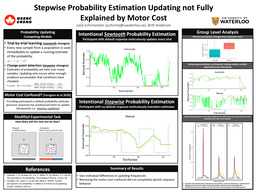Is Intermittent Updating of Probability Estimates Due to Motor Costs?
A decade ago an excellent article with an educational reminder of some forgotten history was published by Gallistel and colleagues.1 The main method was to observe the trial by trial reports of participants estimating the Bernoulli parameter while observing a sequence of "coin flips" with intermittent changes in the underlying, true, parameter. The main conclusion was that participants were not doing trial-by-trial updating, because their reports showed a step-and-hold pattern of updating. What Julia Schirmeister investigated was a possible motor confound, identified by Forsgren in their rebuttal.2
It takes more effort in the traditional administration of the task to update one's estimate than to leave it be. So, a reasonable strategy might be to tolerate a little bit of imprecision and save yourself some work (especially if you are an undergraduate participating for course credit and have a goal to minimize time on task as much or more than accuracy). While the basic data are in her thesis Julia has continued to refine her analysis. A manuscript is under review, but you can get a recent take on it by looking at her poster she recently presented at the 2024 Cognitive Neuroscience Society meeting that was held in Toronto.
Footnotes:
C. R. Gallistel et al., “The Perception of Probability.,” Psychological Review 121, no. 1 (2014): 96–123, https://doi.org/10.1037/a0035232.
Mattias Forsgren, Peter Juslin, and Ronald van den Berg, “Further Perceptions of Probability: In Defence of Trial-by-Trial Updating Models,” 2020, https://doi.org/10.1101/2020.01.30.927558.
